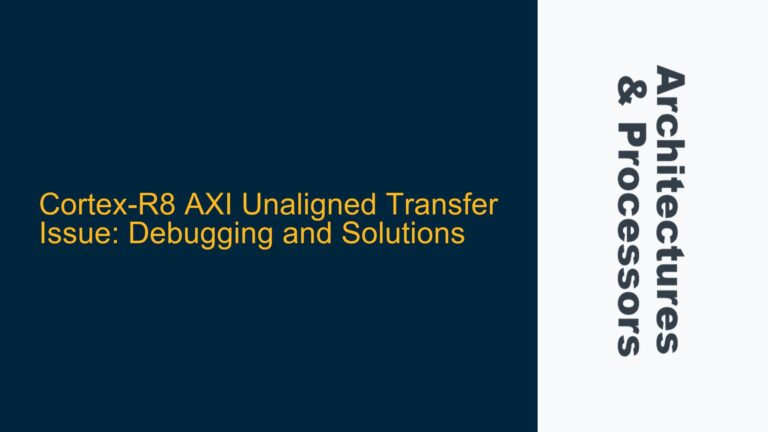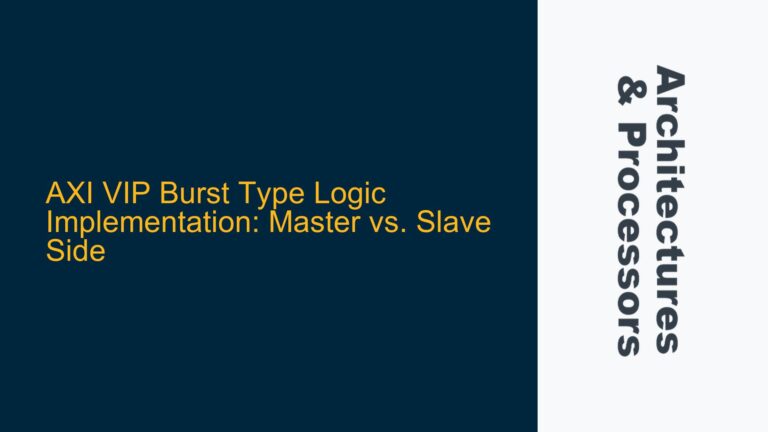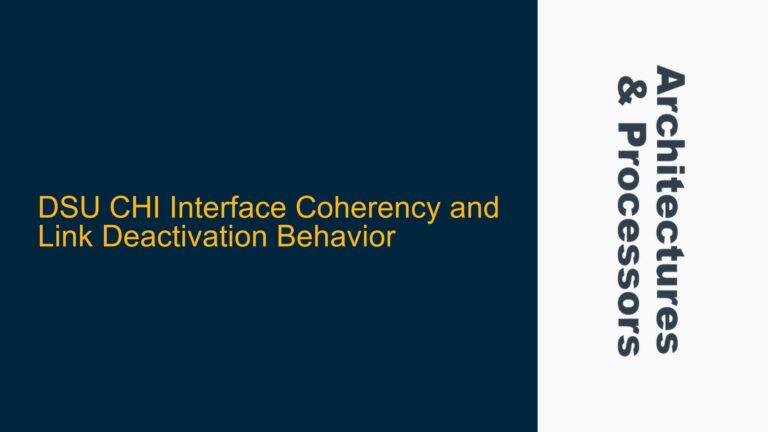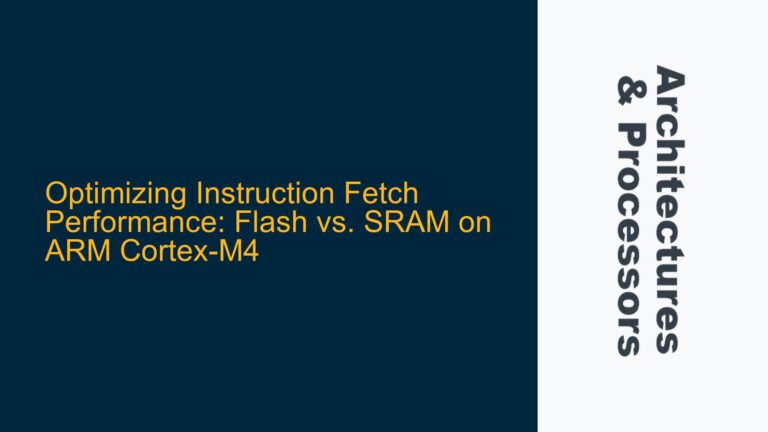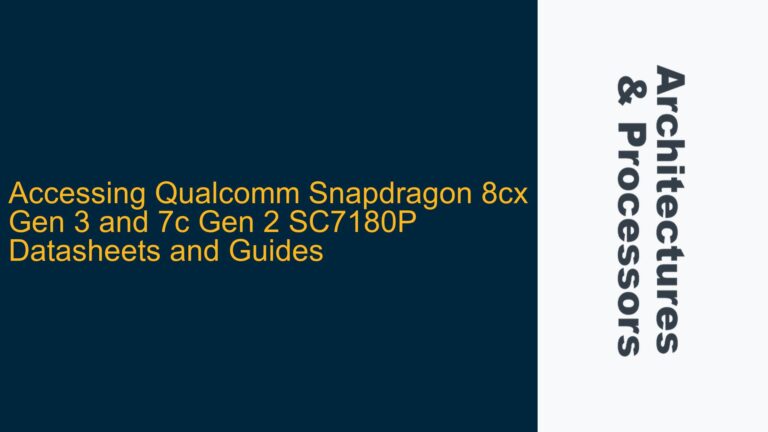ARM Cortex-A53 MMU Configuration Challenges in Identity Mapping
The ARM Cortex-A53 processor, a popular choice for embedded systems, leverages a Memory Management Unit (MMU) to handle virtual-to-physical address translation. However, in certain bare-metal or tightly controlled environments, developers may seek to enable identity mapping—where virtual addresses (VA) directly correspond to physical addresses (PA)—without incurring the performance overhead of page table walks. This scenario arises when the system operates without memory protection requirements, and the goal is to maximize performance by avoiding Translation Lookaside Buffer (TLB) misses and subsequent page walks.
The Cortex-A53 MMU is designed to support multi-stage translation tables, which are essential for complex operating systems but can introduce latency in systems where memory protection is unnecessary. The challenge lies in configuring the MMU to enforce identity mapping across the entire physical memory space without triggering page walks. This is particularly difficult because the ARMv8 architecture does not provide a direct mechanism to disable page walks entirely. Instead, the MMU relies on translation tables, and any TLB miss will result in a page walk, which can degrade performance in memory-intensive applications.
The core issue is that the Cortex-A53 MMU does not natively support a "no-walk" mode for identity mapping. While the MMU can be configured to use large blocks (e.g., 1GB or 2MB sections) to minimize the number of page table entries, this approach does not eliminate page walks entirely. Furthermore, the Cortex-A53 lacks features like TLB lockdown, which could mitigate the performance impact of TLB misses. As a result, developers must explore alternative strategies to approximate identity mapping while minimizing the performance overhead associated with page walks.
Memory Mapping Constraints and TLB Miss Overheads
The primary obstacle to achieving identity mapping without page walks on the Cortex-A53 stems from the architecture’s reliance on translation tables. The MMU uses these tables to resolve virtual addresses to physical addresses, and any TLB miss triggers a page walk to fetch the necessary translation from memory. This process introduces latency, which can be particularly problematic in real-time or high-performance systems.
One potential workaround is to configure the MMU to use the largest possible block sizes for memory mapping. For example, using 1GB or 2MB blocks reduces the number of page table entries, thereby decreasing the likelihood of TLB misses. However, this approach does not eliminate page walks entirely, as the TLB has a finite capacity (typically 512 entries on the Cortex-A53). When the working set of memory exceeds the TLB’s capacity, misses will occur, and page walks will be triggered.
Another consideration is the physical address (PA) range of the system. The Cortex-A53 MMU supports a 48-bit virtual address space, but the physical address space may be smaller or fragmented. In such cases, it may not be possible to identity-map the entire PA range using a single linear mapping. Instead, developers must carefully configure the MMU to map the PA range to a contiguous virtual address range, ensuring that the mapping is as efficient as possible. This requires a deep understanding of the system’s memory map and the MMU’s capabilities.
Additionally, the Cortex-A53 MMU does not support a direct mechanism to disable page walks. While it is possible to disable the MMU entirely, this would also disable the data cache (DCache), which is often undesirable. Enabling the DCache without the MMU can lead to cache coherency issues, as the cache relies on the MMU’s address translation to maintain consistency. Therefore, developers must balance the need for identity mapping with the performance benefits of the DCache.
Implementing Linear VA-to-PA Mapping and Cache Management
To approximate identity mapping on the Cortex-A53 while minimizing the performance impact of page walks, developers can implement a linear virtual-to-physical address mapping. This approach involves configuring the MMU to map the entire physical address range to a contiguous virtual address range using the largest possible block sizes. While this is not a true identity mapping, it simplifies the address translation process and reduces the likelihood of TLB misses.
The first step is to define the virtual address (VA) range that will be used for the mapping. This range should be large enough to cover the entire physical address (PA) range of the system. For example, if the PA range is 4GB (0x00000000 to 0xFFFFFFFF), the VA range could be defined as 0xFFFF00000000 to 0xFFFFFFFFFFFF. The MMU can then be configured to map this VA range to the PA range using 1GB or 2MB blocks.
The translation functions for converting between VA and PA are straightforward:
va_to_pa(va) = va - VA_BASE + PA_BASE
pa_to_va(pa) = pa - PA_BASE + VA_BASE
Here, VA_BASE is the base address of the virtual address range, and PA_BASE is the base address of the physical address range. By using these functions, developers can ensure that the mapping is linear and efficient.
However, this approach requires careful consideration of the system’s memory map. Some regions of the physical address space may be reserved for peripherals or other non-RAM devices, and these regions must be mapped with the appropriate memory attributes (e.g., Device memory). Failure to do so can result in incorrect memory access behavior or performance degradation.
To further optimize performance, developers can enable the DCache while ensuring that the MMU is configured to maintain cache coherency. This involves setting the appropriate memory attributes in the MMU’s translation tables and using barriers to ensure that data is synchronized between the cache and memory. For example, the Data Synchronization Barrier (DSB) and Instruction Synchronization Barrier (ISB) instructions can be used to enforce ordering and ensure that the cache is properly managed.
In cases where the TLB capacity is a limiting factor, developers can explore software-based techniques to minimize TLB misses. For example, memory access patterns can be optimized to reduce the working set of memory that is actively used. Additionally, the use of large pages can help reduce the number of TLB entries required to map a given memory region.
Finally, developers should consider the trade-offs between using the Cortex-A53 and other ARM processors that may better suit their requirements. For example, the Cortex-R series processors, which are designed for real-time applications, include features like an MPU (Memory Protection Unit) that can enforce identity mapping without the overhead of page walks. While these processors may not offer the same level of performance as the Cortex-A53, they may be better suited for systems where deterministic performance is critical.
In conclusion, while the Cortex-A53 MMU does not natively support identity mapping without page walks, developers can approximate this behavior through careful configuration of the MMU and optimization of memory access patterns. By leveraging linear VA-to-PA mapping, enabling the DCache, and minimizing TLB misses, it is possible to achieve a high-performance system that meets the requirements of bare-metal or tightly controlled environments.


